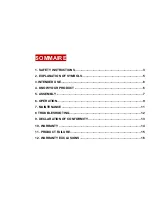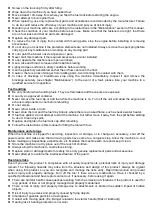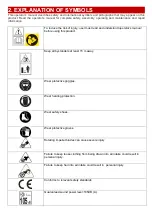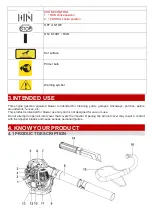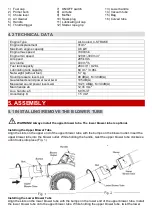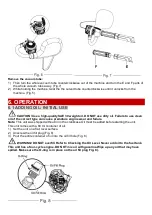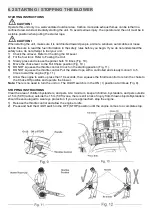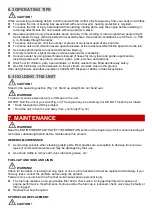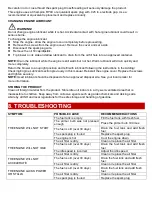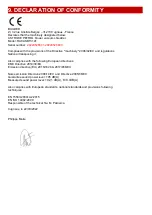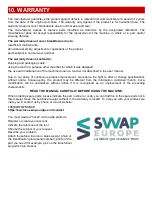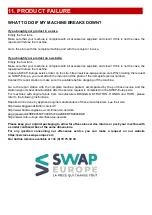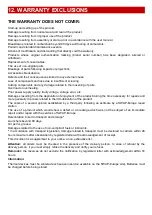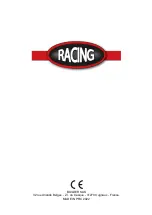
1. SAFETY INSTRUCTIONS
1.2 GENERAL WARNINGS
WARNING: For your own safety, please read this manual before attempting to operate your new unit.
Failure to follow instructions can result in serious personal injury. Spend a few moments to familiarize
yourself with your blower before each use. If you give this tool to another person, also hand over this
manual.
Use this tool as described in this manual. Any mishandling and any use contrary to the instructions
will not in any way engage the liability of the manufacturer.
Non-compliance with safety instructions and use can cause a risk of electric shock, fire and /or injury
to persons.
READ YOUR USER MANUAL THOROUGHLY BEFORE OPERATING YOUR UNIT.
Never allow children, handicapped or inexperienced people to use the machine. Local regulations may
restrict the age of the user.
Keep children, bystanders and animals away from the machine when using it (at least 15 meters).
Remember that the user is responsible for accidents or damage to people or their property.
Never dismantle the machine by yourself. Any disassembly or repair must be carried out by qualified
personnel.
Always wear personal protective equipment (PPE)
Wear long, thick pants, boots, eye protection and safety gloves. Do not wear loose clothing, shorts or
jewellery, and never work barefoot.
To reduce the risk of injury, never wear loose clothing, scarf, collar, chain, etc. as they could get caught in
moving parts. If you have long hair, be sure to tie it above shoulder level to prevent it from getting caught
in the moving parts.
The machine is extremely noisy and requires the use of good quality hearing protection every time you
use it.
Carry the machine only by its handle. Never try to wear it in other places.
Refuel only in safe places. Open the tank slowly to release any pressure that may have built up in the tank.
Clean any gasoline or spills from the machine before using it. To prevent any risk of fire, move at least 10
meters away from the refuelling area before starting the machine.
Switch off the machine before any preparation, installation or maintenance.
All machine screws should be properly seated and tightened securely. The machine must be in good
working order. Never use this machine if it is not assembled correctly.
Keep handles clean and dry and free from gasoline or oil.
Always store the machine in a clean and dry place away from all electrical equipment.
Never start the engine in a closed or poorly ventilated room as the exhaust gases can be fatal.
Only operate the machine at reasonable times - not too early in the morning or late at night, when people
may be disturbed.
Never use the machine in bad weather or if there is a risk of lightning or thunderstorms. Do not use in the
rain or in wet areas.
Do not use this machine if you are tired, sick, under the influence of alcohol or drugs, or if you are taking
medication.
Do not use this machine in a poorly lit area.
Keep a safe distance from moving parts and never touch surfaces that become hot during use.
Wear a mask that filters out microscopic particles if your work generates dust, to avoid the risks associated
with inhaling harmful dust.
Before starting the machine, clear the area where you are going to use it. Remove stones, broken glass,
nails, wire ropes, ropes or other objects that could be thrown or get caught in the machine.
Always keep a good balance. Support yourself well on your legs and do not extend your arm too far.
Otherwise, you could fall, slip or injure yourself.
Let your machine cool down before putting it away.
Before transporting this machine in a vehicle, empty the fuel tank and secure the machine so that it cannot
move during transport.
To reduce the risk of fire and burns, handle fuel with care. It is an extremely flammable substance.
Do not smoke when handling fuel.
Mix and store fuel in a container designed to hold gasoline.
Mix the fuel in the open air, away from any sparks or flames.
Choose a clean, bare surface, stop the engine, and allow it to cool before filling it.
Slowly unscrew the fuel cap to relieve pressure and prevent fuel from spilling around the cap.


